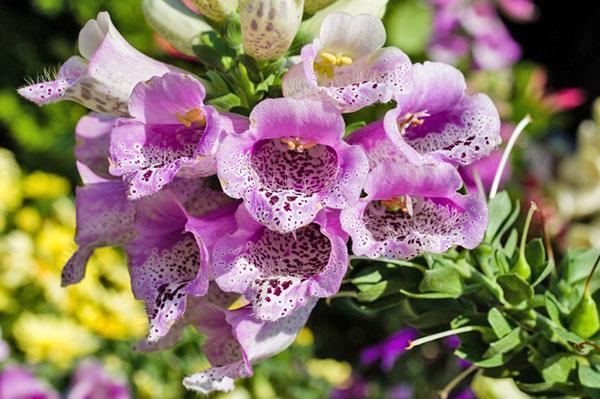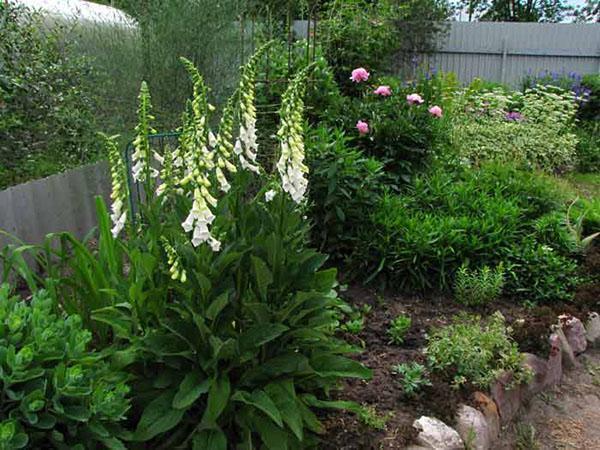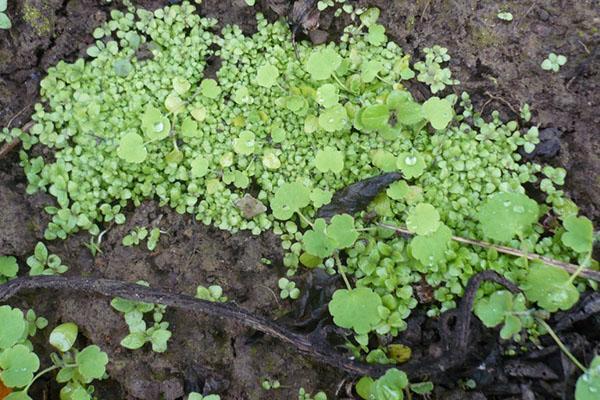Live and learn: how to grow digitalis correctly
 Your garden already has a huge number of different flowers. These are annuals and perennials, early flowering and autumn flowering, tall and short. If foxglove is not yet visible among this variety, we recommend that you pay attention to this plant and be sure to settle it in your garden. Today we will tell and show you how to grow a foxglove.
Your garden already has a huge number of different flowers. These are annuals and perennials, early flowering and autumn flowering, tall and short. If foxglove is not yet visible among this variety, we recommend that you pay attention to this plant and be sure to settle it in your garden. Today we will tell and show you how to grow a foxglove.
Description of the delicate plant

Digitalis herbs are perennial or biennial. Their genus has about 36 species, which live mainly in the Mediterranean, in Western Asia and North Africa, in the rest of Europe, and also on the Canadian Islands.
 The beauty of digitalis is considered a popular medicine and an interesting part of the decor, as well as valuable honey plant... The stems are stately, strong, unbranched, growing from 30 to 150 cm high. Its leaves are notable, light green in color, oval, oblong in shape. Inflorescences of irregular shape, in the form of a bell, yellow or red, sometimes purple with more darkened dots and specks, are accumulated in a one-sided ear.
The beauty of digitalis is considered a popular medicine and an interesting part of the decor, as well as valuable honey plant... The stems are stately, strong, unbranched, growing from 30 to 150 cm high. Its leaves are notable, light green in color, oval, oblong in shape. Inflorescences of irregular shape, in the form of a bell, yellow or red, sometimes purple with more darkened dots and specks, are accumulated in a one-sided ear.
But how do you get such a variety? Let's look at the options.
How to grow by seeds
 It is advisable to purchase grains of this family from trusted gardeners. It often happens that completely different herbs appear under the name of varietal digitalis. And, of course, pay attention to expiration dates.
It is advisable to purchase grains of this family from trusted gardeners. It often happens that completely different herbs appear under the name of varietal digitalis. And, of course, pay attention to expiration dates.
Do you need pre-processing
The seeds do not need additional stratification processing and any other manipulations. But to speed up the process of emergence of sprouts, you can pre-soak. So, let's figure out how to plant foxglove seeds.
 It is better to sow in greenhouses or a greenhouse, in early April or May. Prepare the land in advance, and before sowing - loosen a little and water generously. Then sprinkle the seeds as seldom as possible with fairly loose aisles. If advance soaking was not carried out, then the crops are covered from above with a film or glass (it is removed as soon as the sprouts break through).
It is better to sow in greenhouses or a greenhouse, in early April or May. Prepare the land in advance, and before sowing - loosen a little and water generously. Then sprinkle the seeds as seldom as possible with fairly loose aisles. If advance soaking was not carried out, then the crops are covered from above with a film or glass (it is removed as soon as the sprouts break through).
Maintain room temperature air and provide ambient light.
Care of digitalis seedlings

To achieve maximum results, adhere to the following recommendations:
- Carry out a pick in separate pots, as soon as three or more real leaves are formed. Plant in large boxes with a distance of 5-7 cm between shoots or in individual containers.
- Water the seedlings sparingly and avoid drying out, and at times gently loosen the substrate around them.
- It is extremely important to protect seedlings from direct sunlight and drafts.
- A week before planting, the seedlings should be periodically taken out into the cool air, hardened. Thus, she will prepare herself for being in the garden.
- When the maximum time spent on the street reaches a day, then this is a sign that it is time to plant the plantain family in prepared and fed soil.
Do not let the soil dry out.
How to grow by seed outdoors
 Quite often, foxglove seeds are grown immediately in the garden or in a flower bed, where it also germinates and ripens well. The most suitable months for planting and caring foxgloves in the open field are the months of May and June, when all frosts are already behind.
Quite often, foxglove seeds are grown immediately in the garden or in a flower bed, where it also germinates and ripens well. The most suitable months for planting and caring foxgloves in the open field are the months of May and June, when all frosts are already behind.
 Seeds are planted in places where there is no excess moisture. Before sowing, make mineral fertilizers with nitrogen, phosphorus and potassium. Sow in lines with a width of 20-25 cm between them, sprinkle with a little sand and cover with a covering non-woven material.
Seeds are planted in places where there is no excess moisture. Before sowing, make mineral fertilizers with nitrogen, phosphorus and potassium. Sow in lines with a width of 20-25 cm between them, sprinkle with a little sand and cover with a covering non-woven material.
Features of planting and care
 Consider when to plant foxglove seedlings in open ground. Planting occurs in early summer in fertilized soft soil. The gap between the seedlings should be 20 cm, and the row spacing should be about 25 cm. The holes are made deep, and the seedlings are planted with an earthen clod. After that, the soil is carefully compacted and moistened.
Consider when to plant foxglove seedlings in open ground. Planting occurs in early summer in fertilized soft soil. The gap between the seedlings should be 20 cm, and the row spacing should be about 25 cm. The holes are made deep, and the seedlings are planted with an earthen clod. After that, the soil is carefully compacted and moistened.
Despite its hardiness to cold winters and small summer droughts, as well as resistance to acid changes in the soil, there are some nuances in the choice of location.

Tips for choosing a landing site:
- Since digitalis does not tolerate waterlogged soil, drainage is established during planting.
- Before planting seedlings, plowing is carried out to the depth of the arable horizon (20 cm), manure, wood ash are introduced into it, compost or nitrophoska. If there is a high acidity, then a small amount of lime is added.
- An open, light or slightly darkened place is chosen.
- When planting, it is important to pay attention to deciduous trees, because water can stagnate through the autumn leaves.
Seasonal outdoor care
 If the place of planting and caring for the perennial foxglove is chosen in accordance with the requirements, then the care will not be so difficult. It just requires regular watering. But at the same time it is necessary to ensure that water does not remain at the roots.
If the place of planting and caring for the perennial foxglove is chosen in accordance with the requirements, then the care will not be so difficult. It just requires regular watering. But at the same time it is necessary to ensure that water does not remain at the roots.
Planting is carried out only in high-quality, loose soil. The plant does not like excessive moisture, therefore good drainage is imperative.
At the beginning of flowering and in spring, complex mineral fertilizers are used. In turn, nitrogen is added 2 times a season. The roots of digitalis can be exposed at the beginning of autumn, do not forget to check. In order to preserve their viability in the winter, we warm them well with soil.
Seeds are collected for breeding in mid-autumn. The lower bolls act as a sign for collection, which change their color to brown or yellow, and the peduncles are cut off. Dry leaves are cut in the spring. During the flowering period, wilted flowers can be removed.
Perennial view
 It includes a huge number of varieties that have not only medicinal properties, but also an interesting unusual look.
It includes a huge number of varieties that have not only medicinal properties, but also an interesting unusual look.
For many hundreds of years, perennials have been used in folk medicine. They are quite unpretentious, withstand a small amount of light, and even frost. Great for landscape designers. And this is not surprising, because lush bushes with high inflorescences can decorate almost any place in a summer cottage. You can start work in early summer by planting seeds directly into the garden. But it is better to prepare a flower bed in the fall, you need to dig it up, then add a little humus and river sand. In the spring, dig up again, loosen the ground with a garden rake.
Flowering time
 Sunny summer is exactly the time when the foxglove blooms. It is undemanding to soils and climate features. The inflorescences of this family are brighter and more luxuriant when they grow in partial shade, and not in the sun. A box with small brown seeds is their fruit (about 10,000 grains in 1 g), which are suitable for 2-3 years, but it usually does not exceed 50%. Also, you can admire the flowering only in the 2nd year of life.
Sunny summer is exactly the time when the foxglove blooms. It is undemanding to soils and climate features. The inflorescences of this family are brighter and more luxuriant when they grow in partial shade, and not in the sun. A box with small brown seeds is their fruit (about 10,000 grains in 1 g), which are suitable for 2-3 years, but it usually does not exceed 50%. Also, you can admire the flowering only in the 2nd year of life.
Experts do not recommend planting the plant where children play, as it releases harmful juice!
We hope our article was useful to you! We are confident that by listening to our recommendations, you will be amazingly decorating your garden!